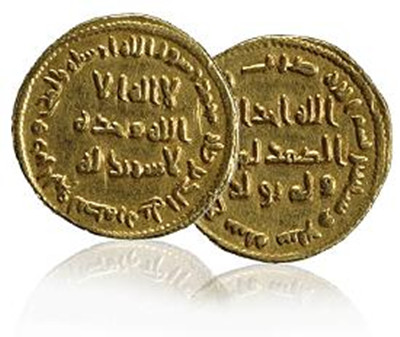And it appears on this coin. But this coin also tells us something else. If coins reflect the dominant power in a society, it's clear that the dominant power in this empire is now not the emperor but the word of God. Portraiture or figurative art has no place in the official documents of such a state. The tradition of placing the ruler on the coin, familiar across the Middle East since the days of Alexander, had been decisively abandoned. And the text-only coin remained the norm in all Islamic states until the First World War. Arabic, the language of God, inscribed on an Islamic coinage, became a fundamental tool for the integration and survival of the first Islamic state.
這也就是這枚硬幣上的文字。此外,金幣也表明,這一帝國的統(tǒng)治力量不是君王,而是真主。此后,帝國的官方文獻上再也沒有出現(xiàn)任何人像或?qū)憣嵥囆g(shù)。 曾流行于整個中東地區(qū)的將帝王像置于貨幣上的傳統(tǒng)始于—千年前的亞歷山大時期,如今被廢棄了。直到一戰(zhàn)之前,這種只有文字的硬幣形式 —直是伊斯蘭世界的標準。而阿拉伯語,鐫刻于貨幣之上的真主的語言,成為第一個伊斯蘭王朝整合與生存的基本工具。
Abd al-Malik, Khalifah Allah, Deputy of God, Ninth Caliph and Ruler of the Faithful, died in 705. But the message proclaimed on his coins of a universal empire of faith still resonates strongly.
公元705年,阿卜杜勒馬利克,這位真主使者的繼承人、安拉的代理人、第九代哈里發(fā)和信徒的領(lǐng)路人去世了。但在這個以信仰為基礎(chǔ)的帝國里,由他鐫刻在貨幣上的信息至今仍影響深遠。
Today there is no caliph-long claimed by the Turkish sultans, the office was abolished in 1924. In fact, a universally accepted caliph has always been a rare thing, but the dream of a single Islamic empire-a caliphate-remains potent in the modern Islamic world. We asked the social anthropologist Professor Madawi al-Rasheed to comment:
如今的世界上已沒有哈里發(fā)了。這個頭銜長期以來由土耳其的蘇丹繼承,1924正式廢止。在歷史上得到廣泛承認的哈里發(fā)極少。但建立一個統(tǒng)一的哈里發(fā)帝國的夢想在現(xiàn)代的伊斯蘭社會仍極有號召力。 我曾詢問過社會人類學(xué)家馬達維?拉西德對這一點的看法:
"Muslims today, at least some sections of the Muslim community worldwide, aspire to this ideal of the caliphate as the embodiment of the Muslim community.
今天的穆斯林,至少世界穆斯林社區(qū)中的某部分穆斯林,十分渴望哈里發(fā)國家的理想能實現(xiàn)于現(xiàn)實中的伊斯蘭社會。












